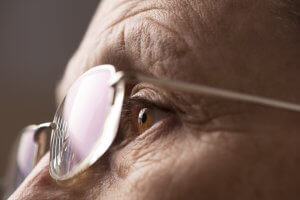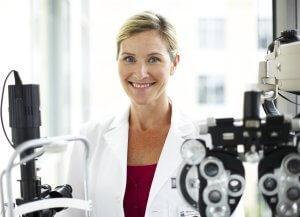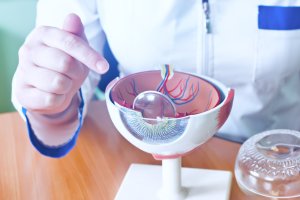“Great patient care, high medical skills with compassion for the patients...”
— Actual patient review posted on HealthGrades.com
Count on the macular degeneration experts at Eye Consultants of Pennsylvania
Macular degeneration, or age-related macular degeneration (AMD), is a leading cause of vision loss in Americans 60 and older. It is a disease that destroys your sharp, central vision. You need central vision to see objects clearly and to do tasks such as reading and driving.
What are macular degeneration symptoms? AMD affects the macula, the part of the eye that allows you to see fine detail. It does not hurt, but it causes cells in the macula to die. In some cases, AMD advances so slowly that people notice little change in their vision. In others, the disease progresses faster and may lead to a loss of vision in both eyes.
There are two forms of age-related macular degeneration — dry and wet.
- Dry AMD: Dry AMD occurs when the light-sensitive cells in the macula slowly break down, gradually blurring central vision in the affected eye. As dry AMD gets worse, you may see a blurred spot in the center of your vision. Over time, as less of the macula functions, central vision in the affected eye can be lost gradually.
- Wet AMD: Wet AMD occurs when abnormal blood vessels behind the retina start to grow under the macula. These new blood vessels tend to be very fragile and often leak blood and fluid. The blood and fluid raise the macula from its normal place at the back of the eye.
Regular comprehensive eye exams can detect macular degeneration before the disease causes vision loss. Treatment can slow vision loss. It does not restore vision. That’s why early diagnosis and macular degeneration treatment are always the best options.
When it comes to macular degeneration, insist on the experts
Each of our macular degeneration specialists is Board-Certified and Fellowship-Trained. That’s quality and experience you can trust. They utilize the latest technology and enjoy an excellent reputation and high patient satisfaction. From the first moment a friendly staff member greets you, throughout your treatment, you’ll receive the compassionate care and personal attention that you deserve.
Diabetic Eye Care, Macular Degeneration, Retinal Eye Care
Board-Certified, Fellowship-Trained
Wyomissing, Pottsville, Lebanon
Diabetic Eye Care, Macular Degeneration, Retinal Eye Care
Board-Certified, Fellowship-Trained
Wyomissing, Pottstown, Pottsville
Diabetic Eye Care, Macular Degeneration, Retinal Eye Care
Board-Certified, Fellowship-Trained
Wyomissing, Pottstown, Pottsville
What are the risk factors?
The risk for AMD increases with age. AMD is most common in older people, but it can occur during middle age. Generally, though, the risk increases with age. Other risk factors include:
- Smoking
- Obesity
- Whites are much more likely to lose vision from AMD than African-Americans.
- Family history. People with a family history of AMD are at higher risk of getting the disease.
- Women appear to be at greater risk than men.
What are the symptoms?
AMD blurs the sharp central vision you need for straight-ahead activities such as reading, sewing, and driving. AMD causes no pain. In some cases, AMD advances so slowly that people notice little change in their vision. In others, the disease progresses faster and may lead to a loss of vision in both eyes. AMD is a common eye condition among people age 50 and older. It is a leading cause of vision loss in older adults.
The most common symptom of dry AMD is slightly blurred vision. You may have difficulty recognizing faces. You may need more light for reading and other tasks. Dry AMD generally affects both eyes, but vision can be lost in one eye while the other eye seems unaffected.
Another of the most common early signs of dry AMD is drusen. Drusen are yellow deposits under the retina. They often are found in people over age 60. Some people see a blurred spot in the center of their vision. More light may be needed for reading and other tasks. More advanced dry AMD can cause a blurred spot in the center of your vision. Over time, the blurred spot may get bigger and darker, taking more of your central vision. You may have difficulty reading or recognizing faces until they are very close to you.
An early symptom of wet AMD is that straight lines appear wavy. If you notice this condition or other changes to your vision, contact your eye care professional at once. You need a comprehensive dilated eye exam. With wet AMD, loss of central vision can occur quickly. Wet AMD is considered to be advanced AMD and is more severe than the dry form.
With either wet or dry AMD, vision lost cannot be restored. That’s why early detection and treatment is the best way to limit the negative effects of macular degeneration. Schedule a comprehensive eye exam with an experienced retinal disease specialist at least once each year.
What are my treatment options?
Once Dry AMD reaches the advanced stage, no form of treatment can prevent vision loss. However, treatment can delay and possibly prevent intermediate AMD from progressing to the advanced stage. The National Eye Institute's Age-Related Eye Disease Study found that taking certain vitamins and minerals may reduce the risk of developing advanced AMD.
Wet AMD can be treated with laser surgery, photodynamic therapy, and injections into the eye. None of these treatments is a cure for wet AMD. The disease and loss of vision may progress despite treatment.
- Laser Surgery: Laser surgery uses a laser to destroy the fragile, leaky blood vessels. Only a small percentage of people with wet AMD can be treated with laser surgery. Laser surgery is performed in a doctor's office or eye clinic. The risk of new blood vessels developing after laser treatment is high. Repeated treatments may be necessary. In some cases, vision loss may progress despite repeated treatments.
- Photodynamic Therapy: With photodynamic therapy, a drug called verteporfin is injected into your arm. It travels throughout the body, including the new blood vessels in your eye. The drug tends to stick to the surface of new blood vessels.
- Next, the doctor shines a light into your eye for about 90 seconds. The light activates the drug. The activated drug destroys the new blood vessels and leads to a slower rate of vision decline.
- Unlike laser surgery, verteporfin does not destroy surrounding healthy tissue. Because the drug is activated by light, you must avoid exposing your skin or eyes to direct sunlight or bright indoor light for five days after treatment. Photodynamic therapy is relatively painless. It takes about 20 minutes and can be performed in a doctor's office.
- Photodynamic therapy slows the rate of vision loss. It does not stop vision loss or restore vision in eyes already damaged by advanced AMD. Treatment results often are temporary. You may need to be treated again.
- Drug Treatment for Wet AMD: Wet AMD can now be treated with new drugs that are injected into the eye (anti-VEGF therapy). Abnormally high levels of a specific growth factor occur in eyes with wet AMD and promote the growth of abnormal new blood vessels. This drug treatment blocks the effects of the growth factor.
- You will need multiple injections that may be given as often as monthly. The eye is numbed before each injection. After the injection, you will remain in the doctor's office for a while and your eye will be monitored. This drug treatment can help slow down vision loss from AMD and in some cases improve sight.
Learn more about macular degeneration diagnosis and treatment.
“I wish I would have done this years ago instead of suffering through my cataract and vision problems.”
What do our patients say?
See what our patients say about the doctors at Eye Consultants of Pennsylvania.
Take the first step
A a careful, dilated eye examination by one of our retinal specialists is the first step. Our doctors use very specialized technologies — and years of training and experience — to examine your eyes and check for the presence of disease. At your examination, your doctor will personally discuss with you the health of your eyes, how your condition is affecting your vision and what treatment options are available. The bottom line: trust the experts. Insist on Eye Consultants of Pennsylvania.
Does my insurance plan
cover my eye care?
Find out what insurance we accept and what is covered by insurance.
Learn more about
macular degeneration
We’re committed to patient education. Get more information about macular degeneration, including diagnoses and treatment options.
Schedule an Appointment
Schedule an appointment with one of our specialists.





